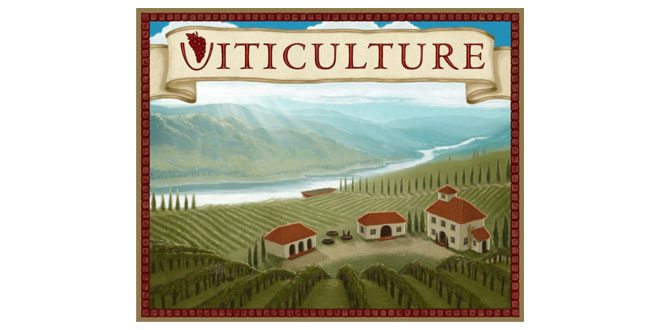There are few games that I have played that I just never wanted to end. For example, the first time I played Pastiche, we played for hours, ignoring the scoring — it was that much fun. Like the art-based, card-drafting game, Viticulture was so enjoyable to play, we were saddened when the scoring track came to an end and we had to declare a winner. What makes this game so great? Let’s take a look at this new board game where players compete to make and sell wine.
First, some bad news: Viticulture isn’t available in stores yet. The game is still being funded on Kickstarter and the campaign will end next Monday. I played a print & play version of this game, so components will definitely be changing from what you see in the photos.
Now, on to the good news: Viticulture is wonderfully fun. It progresses nicely and everyone I played with, winners and losers alike, really enjoyed their experiences. The rules are complicated enough to allow for a variety of strategies, but simple enough that everyone was an expert after a few rounds of the game. The mechanics are solid and it’s definitely a game you should look into backing.
Gameplay
Viticulture is a worker placement game set in the Tuscany region of Italy. You own a vineyard and are competing to make and sell different varietals of wine. The play experience is supposed to be the same whether you’re playing with two players or six. I played with two and four players and the experience was mostly similar.
(Click here if you’d rather watch the game’s designers play a couple of rounds. You can also read the complete rules here.)
Setup is easy; there is a shared game board and each player receives 3 worker tokens, some money, a couple of cards from the game’s four different decks, and an individual vineyard playmat.
The goal of the game is to earn more victory points than other players. The ending point is 20 VP, although, when someone reaches 20, the current round is completed and others have the chance to catch (or surpass) the goal of 20. Each round of play is equal to a year, with a round broken into four opportunities to play — one for each season of the year.
In the spring, players take turns deciding who will wake their workers first on a wake-up track. Players who wake first get lesser rewards, but the first opportunity to choose tasks. Players who choose to wake last get better rewards, but may not be able to complete certain tasks.
When summer comes, players can then place their worker tokens on summer activities. Players can build structures, like irrigation or a trellis, increase the size of their wine cellars, or a variety of others that give players an advantage. They can also draw vine cards or plant vine cards, which allow players to grow different grapes on their land. (Although some grapes require a trellis or irrigation to be built before you can plant them.) Players can also give a tour, which earns them money, or sell some grapes.
During this phase, players can play a summer visitor card to benefit their vineyard. The thinking behind the visitor cards is that the vineyard has visitors who might like to help out, either by performing activities that earn the vineyard money or by performing work, which benefits the vineyard in other ways.
When autumn rolls around, visitors arrive to have a look around. At this point, players can draw a summer or winter visitor card, both of which benefit players’ vineyards, as described above.
Finally, as the year draws to a close, play enters the winter phase when players can harvest by moving grapes from the vine to their crush pad; crush grapes and turn them into wine; draw a wine order card; fill a wine order; play a winter visitor card; or train a new worker, giving them an additional worker in the coming years.
Play is then complete for the year, but there are still a few chores to complete. All grape and wine tokens are aged, increasing their value. Workers return from the fields to each player, any payments for open wine orders are completed, hands of cards are discarded down to the limit of seven, and the first player token is rotated.
Play continues until a player has reached a total of 20 victory points.
Conclusions
I liked this game a lot, as did everyone I played with. It was fun and very enjoyable. As soon as we done with our first game (and first bottle of wine), we were ready to play again — though not ready for a second bottle!
The game’s designers call Viticulture a game with “competition, not cut-throatedness” and it’s certainly true. In each round, there are enough things to do that, if someone chose a task you were planning to do, it’s easy to find another task that advances your game.
That’s not to say it’s without a problem or two. At the beginning of the game, money is a challenge, hindering your ability to do much. While this makes for a bit of a slow start, the gripe is in money’s diminishing importance. Toward the end of games I have played, after purchasing everything I needed, the money didn’t really matter at all (your bank is the first tiebreaker item though).
What’s more, some mechanics seem unnecessary in the games we have played, like the yoke that allows uprooting vines. Our games have moved quickly enough that by the time fields are full and you might want to uproot, the game is nearly over. Also, certain wine order cards require mature wines like champagne. Our games didn’t feel long enough to bother with the bubbly. However, I can imagine both of these complaints being remedied by prolonging the scoring track, which is likely to happen in my house rules.
Still, Viticulture is very worth backing. Gameplay runs about 90 minutes and is casual enough that non-gamers might enjoy a game after dinner and a glass of vino. Plus, the strategy is deep enough that serious gamers will enjoy playing. The campaign ends on Monday, so if Viticulture appeals to you, check it out soon.
Disclosure: GeekDad received a demo copy of this game.





